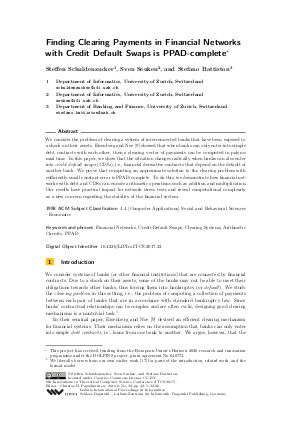Finding Clearing Payments in Financial Networks with Credit Default Swaps is PPAD-complete
Authors Steffen Schuldenzucker, Sven Seuken, Stefano Battiston
-
Part of:
Volume:
8th Innovations in Theoretical Computer Science Conference (ITCS 2017)
Part of: Series: Leibniz International Proceedings in Informatics (LIPIcs)
Part of: Conference: Innovations in Theoretical Computer Science Conference (ITCS) - License:
 Creative Commons Attribution 3.0 Unported license
Creative Commons Attribution 3.0 Unported license
- Publication Date: 2017-11-28
File

PDF
LIPIcs.ITCS.2017.32.pdf
- Filesize: 0.57 MB
- 20 pages
Document Identifiers
Subject Classification
Keywords
- Financial Networks
- Credit Default Swaps
- Clearing Systems
- Arithmetic Circuits
- PPAD
Metrics
- Access Statistics
-
Total Accesses (updated on a weekly basis)
0Document
0Metadata
Abstract
We consider the problem of clearing a system of interconnected banks that have been exposed to a shock on their assets. Eisenberg and Noe (2001) showed that when banks can only enter into simple debt contracts with each other, then a clearing vector of payments can be computed in polynomial time. In this paper, we show that the situation changes radically when banks can also enter into credit default swaps (CDSs), i.e., financial derivative contracts that depend on the default of another bank. We prove that computing an approximate solution to the clearing problem with sufficiently small constant error is PPAD-complete. To do this, we demonstrate how financial networks with debt and CDSs can encode arithmetic operations such as addition and multiplication. Our results have practical impact for network stress tests and reveal computational complexity as a new concern regarding the stability of the financial system.
Cite As Get BibTex
Steffen Schuldenzucker, Sven Seuken, and Stefano Battiston. Finding Clearing Payments in Financial Networks with Credit Default Swaps is PPAD-complete. In 8th Innovations in Theoretical Computer Science Conference (ITCS 2017). Leibniz International Proceedings in Informatics (LIPIcs), Volume 67, pp. 32:1-32:20, Schloss Dagstuhl – Leibniz-Zentrum für Informatik (2017)
https://doi.org/10.4230/LIPIcs.ITCS.2017.32
BibTex
@InProceedings{schuldenzucker_et_al:LIPIcs.ITCS.2017.32,
author = {Schuldenzucker, Steffen and Seuken, Sven and Battiston, Stefano},
title = {{Finding Clearing Payments in Financial Networks with Credit Default Swaps is PPAD-complete}},
booktitle = {8th Innovations in Theoretical Computer Science Conference (ITCS 2017)},
pages = {32:1--32:20},
series = {Leibniz International Proceedings in Informatics (LIPIcs)},
ISBN = {978-3-95977-029-3},
ISSN = {1868-8969},
year = {2017},
volume = {67},
editor = {Papadimitriou, Christos H.},
publisher = {Schloss Dagstuhl -- Leibniz-Zentrum f{\"u}r Informatik},
address = {Dagstuhl, Germany},
URL = {https://drops.dagstuhl.de/entities/document/10.4230/LIPIcs.ITCS.2017.32},
URN = {urn:nbn:de:0030-drops-81558},
doi = {10.4230/LIPIcs.ITCS.2017.32},
annote = {Keywords: Financial Networks, Credit Default Swaps, Clearing Systems, Arithmetic Circuits, PPAD}
}
Author Details
References
-
Daron Acemoglu, Asuman Ozdaglar, and Alireza Tahbaz-Salehi. Systemic risk and stability in financial networks. American Economic Review, 105(2):564–608, Feb 2015.

-
Franklin Allen and Douglas Gale. Financial contagion. Journal of political economy, 108(1):1-33, 2000.

- Stefano Battiston, J. Doyne Farmer, Andreas Flache, Diego Garlaschelli, Andrew G. Haldane, Hans Heesterbeek, Cars Hommes, Carlo Jaeger, Robert May, and Marten Scheffer. Complexity theory and financial regulation. Science, 351(6275):818-819, 2016. URL: http://dx.doi.org/10.1126/science.aad0299.
-
Stefano Battiston, Michelangelo Puliga, Rahul Kaushik, Paolo Tasca, and Guido Caldarelli. Debtrank: Too central to fail? financial networks, the fed and systemic risk. Scientific reports, 2, 2012.

- X. Chen, X. Deng, and S. h. Teng. Computing nash equilibria: Approximation and smoothed complexity. In 2006 47th Annual IEEE Symposium on Foundations of Computer Science (FOCS'06), pages 603-612, Oct 2006. URL: http://dx.doi.org/10.1109/FOCS.2006.20.
-
Constantinos Daskalakis. On the complexity of approximating a nash equilibrium. ACM Transactions on Algorithms (TALG), 2013. Special Issue for SODA 2011, Invited.

-
Constantinos Daskalakis, Paul W. Goldberg, and Christos H. Papadimitriou. The complexity of computing a nash equilibrium. Electronic Colloquium on Computational Complexity (ECCC), 2005.

- Constantinos Daskalakis, Paul W. Goldberg, and Christos H. Papadimitriou. The complexity of computing a nash equilibrium. Commun. ACM, 52(2):89-97, feb 2009. URL: http://dx.doi.org/10.1145/1461928.1461951.
-
Larry Eisenberg and Thomas H Noe. Systemic risk in financial systems. Management Science, 47(2):236-249, 2001.

- Matthew Elliott, Benjamin Golub, and Matthew O. Jackson. Financial networks and contagion. American Economic Review, 104(10):3115-53, 2014. URL: http://dx.doi.org/10.1257/aer.104.10.3115.
- Brett Hemenway and Sanjeev Khanna. Sensitivity and computational complexity in financial networks. Working Paper, Mar 2015. URL: http://arxiv.org/abs/1503.07676.
-
Daning Hu, J Leon Zhao, Zhimin Hua, and Michael CS Wong. Network-based modeling and analysis of systemic risk in banking systems. MIS Quarterly, 36(4):1269-1291, 2012.

- Christos H. Papadimitriou. On the complexity of the parity argument and other inefficient proofs of existence. Journal of Computer and System Sciences, 48(3):498 - 532, 1994. URL: http://dx.doi.org/10.1016/S0022-0000(05)80063-7.
-
LCG Rogers and Luitgard AM Veraart. Failure and rescue in an interbank network. Management Science, 59(4):882-898, 2013.

- Aviad Rubinstein. Inapproximability of nash equilibrium. In Proceedings of the Forty-Seventh Annual ACM on Symposium on Theory of Computing, STOC '15, pages 409-418, Portland, Oregon, USA, 2015. ACM. URL: http://dx.doi.org/10.1145/2746539.2746578.
-
Aviad Rubinstein. Inapproximability of nash equilibrium. Working Paper, 2016.

- Steffen Schuldenzucker, Sven Seuken, and Stefano Battiston. Clearing payments in financial networks with credit default swaps. Extended abstract in Proceedings of the 17th ACM Conference on Economics and Computation, EC'16, Maastricht, The Netherlands, 2016. ACM. Current Working Paper: URL: http://www.ifi.uzh.ch/ce/publications/Clearing_CDSs.pdf.
- Steffen Schuldenzucker, Sven Seuken, and Stefano Battiston. Finding clearing payments in financial networks with credit default swaps is ppad-complete. Working Paper, 2016. URL: http://www.ifi.uzh.ch/ce/publications/Clearing_PPAD.pdf.
